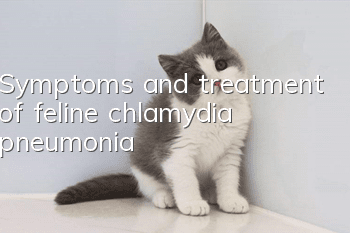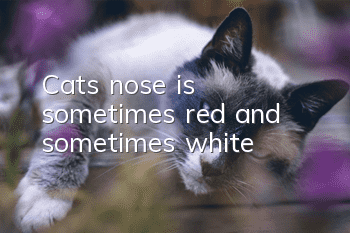Symptoms and treatment of feline chlamydia pneumonia

Feline chlamydia pneumonia is a bacterial infection caused by Chlamydia psittaci, which can also infect birds and humans. Chlamydia psittaci grows and multiplies within the cells lining the respiratory tract, causing irritation and mild symptoms of chlamydia in cats. It may also develop in the gastrointestinal and reproductive tracts but usually causes no symptoms.
Feline chlamydia pneumonia is a highly contagious disease that mainly causes relatively mild chronic upper respiratory tract disease and pneumonia in cats. Chlamydia is a microorganism that is structurally intermediate between bacteria and viruses. Chlamydia can only survive within cells, so it is an absolutely intracellular parasitic bacterium. Chlamydia is quite fragile and unstable once it leaves the host's body and can be easily inactivated by lipid solvents and detergents.
Cat chlamydia infection was initially considered to be the main cause of upper respiratory tract disease in cats, so it was called feline pneumonitis. Later, we gradually learned about feline herpes virus (FHV) and feline cariosis. Viruses (FCV) are the two main causes of the upper respiratory tract, while Chlamydia mainly causes infection of the conjunctiva of the eyes and has a milder impact on the upper respiratory tract. Therefore, the name Feline Pneumonia is not appropriate. It is usually called Feline Pneumonia. Chlamydia infection does not cause pneumonia.
It is currently understood that feline chlamydia is only one of the culprits causing feline upper respiratory tract infection complex syndrome (such as infectious feline rhinotracheitis (details), feline calicivirus). Feline chlamydia is about It accounts for 10%-15% of all cat upper respiratory tract infections, and often occurs at the same time as another upper respiratory tract infection. Therefore, it is not the main culprit, but an auxiliary culprit. When other microorganisms are infected, it takes the opportunity to insert a microorganism. Foot, make up a knife, it is mainly infected in the nose and eyes.
1. Channels of communication
Feline chlamydia can be spread from upper respiratory tract secretions. Common transmission routes include the following: contact with infected objects, such as cat and dog cages, food or water bowls, cat litter boxes, pet owners’ quilts, etc. Contaminated clothing, and pet owner's hands, etc. Contact with discharge from the mouth, nose, or eyes of an infected cat. Exposure to germs from cats when they sneeze and cough within 4 feet. Carrier cats do not show symptoms of the disease; however, the bacteria are hidden in the conjunctiva and can be excreted in eye discharge. In stressful situations (such as the introduction of a new cat), the bacteria excreted in the secretions may increase. Reports of mild conjunctivitis in humans caused by Chlamydia psittaci infection in cats are rare but have occurred.
When cats are infected with chlamydia, clinical symptoms can last for up to several weeks, and may relapse after recovery. Some relapses may be caused by emergencies (such as transportation, anesthesia, surgery, foster care, steroid use, etc.), chlamydiaIt is also easily transmitted to kittens through female cats. However, some reports have found that unweaned kittens are less susceptible to chlamydia. This may be because the passive immunity provided by the mother's colostrum can protect the kittens after they are born. To protect kittens during the first six weeks. After the cat recovers, it will continue to spread the infection to surrounding cats.
2. Symptoms
The initial clinical symptom is conjunctivitis, which is later accompanied by fever, severe tearing, and the eye secretions will become thick. Symptoms of rhinitis may also appear, including: increased nasal secretions, sneezing, and nasal congestion. Concentration, etc.; the later clinical symptoms are suppurative pneumonia, which may cause dyspnea and pulmonary edema due to excessive secretions in the trachea and alveoli. The entire course of the disease lasts approximately 30 days. The bacteria can still be found in the conjunctiva and lungs of sick cats more than 30 days after infection, so sick cats will continue to be infected with the bacteria even if they recover.
3. Treatment
Using antibiotics as the mainstay, good home care, balanced diet, nutritional supplements, and vitamin B complex injections are also necessary in the early stages of the disease. In addition to the topical use of antibiotic-containing eye ointments (3 to 4 times a day), systemic antibiotic administration should be noted as it will have a negative impact on the enamel growth of the developing kitten's teeth, so it is not needed unless the condition worsens.
- How to get your cat to get rid of its bad habit of scratching the wall with its paws?
- Regular check-ups for cats are important to keep your cats healthy!
- What’s wrong with cat’s split nails?
- Should different cats eat different cat foods?
- What are the signs that a Siamese male cat is in heat?
- Do I need an injection if my cat bites it?
- Can British Shorthair cats be neutered during estrus? The best time to neuter British Shorthair cats!
- How to treat colds in Siamese cats?
- Why is the cat sleepy?
- Are cats carnivores or omnivores?



